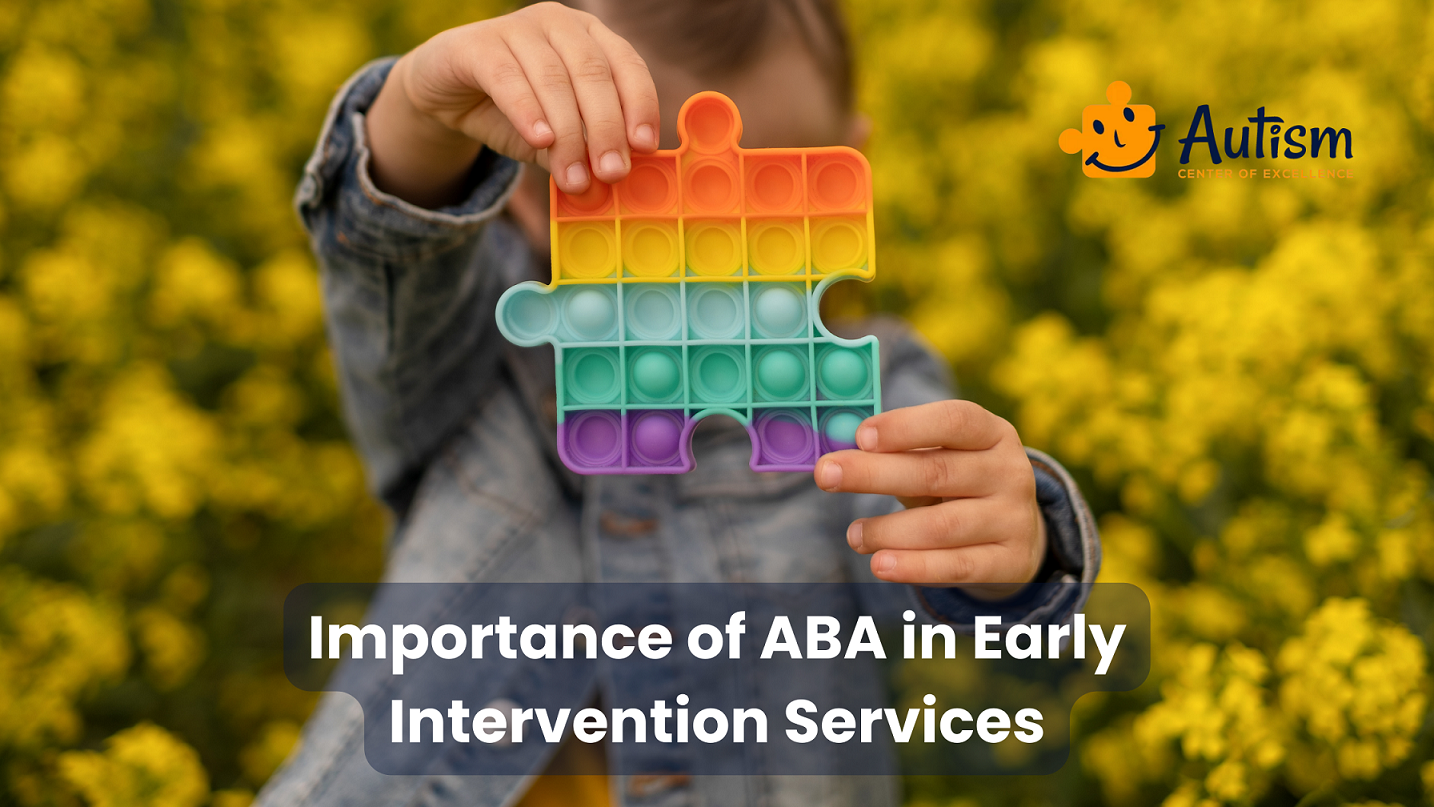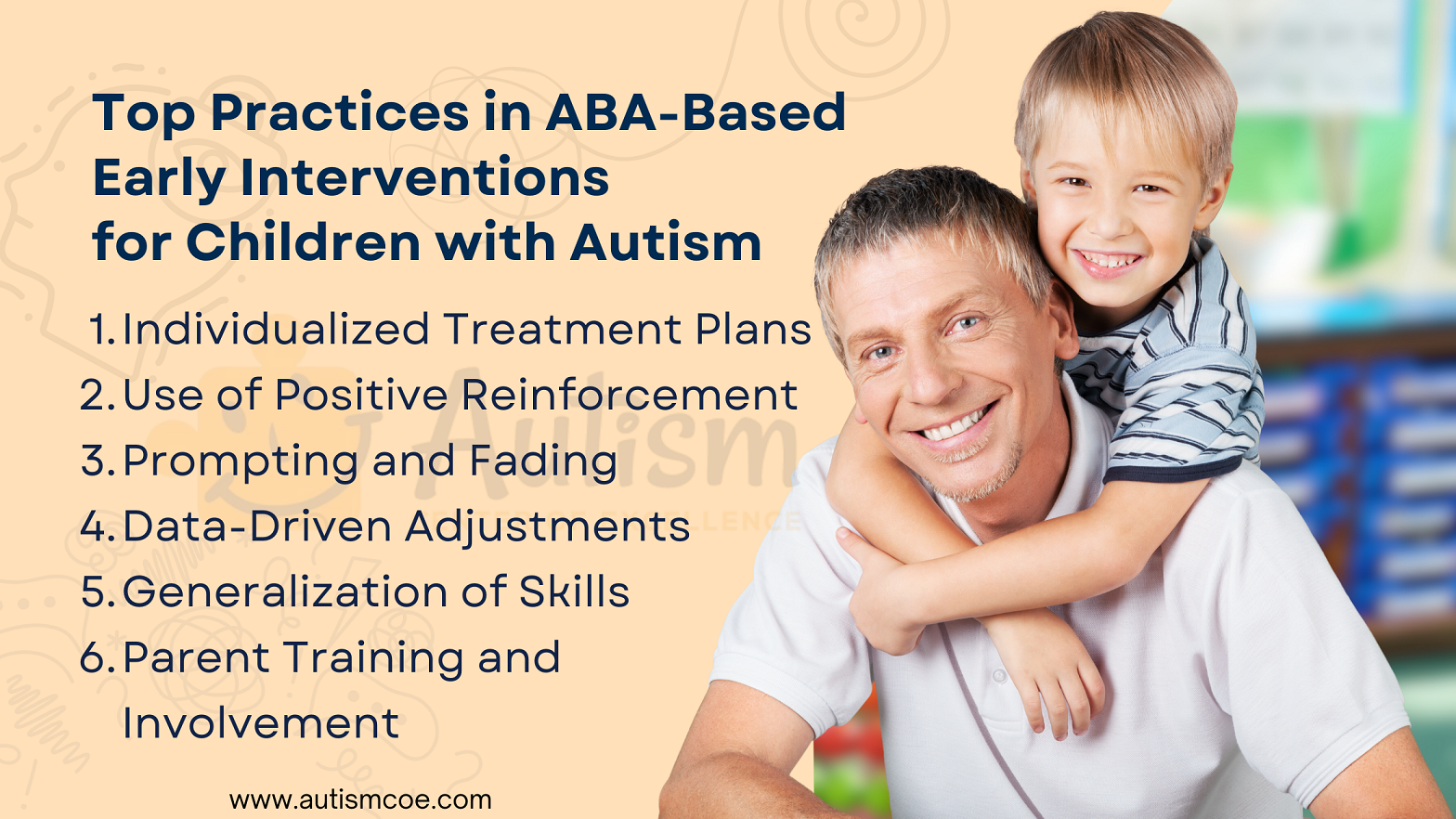Unit 1: ABA-Based Guide to Early Intervention Services for Children With Autism: A Parent’s Handbook

What is ABA-Based Early Intervention for Autism?
ABA-based early intervention for autism includes a therapy curriculum that is appropriate and beneficial for sub-2 years of age children diagnosed with ASD. The purpose is to advance socially significant behaviors like communication, social skills, self-care, play, and motor skills and to reduce undesirable or interfering behaviors.
ABA therapy implemented in a specific program consists of one-on-one instruction by the therapist who uses different approaches and methods. They promote the use of Positive Reinforcement to acknowledge behaviors that are desirable or acquire skills in steps that are easily understood by the learner. The therapist maintains elaborate notes of the child’s progress and data collected is used to revise the treatment plan where needed.
Evaluating Evidence-Based Interventions for Autism
Study has indicated that ABA-based early intervention holds many terrific prospects of improvements in a variety of areas. Children receiving ABA therapy often get such improvements as stronger Intellectual Functioning, language development, and daily living skills. Some children, in particular, may even reach a level of functioning that enables them to successfully take part in mainstream classes without extra support.
Many of the well-established ABA interventions for autism children include Discrete Trial Training (DTT), Natural Environment Teaching (NET), and Pivotal Response Treatment (PRT). The three interventions used are directed at different aspects of development like communication, interaction, and vocational and independent living skills. Working with an experienced practitioner is vital for choosing the intervention that is opportune for your child’s development.

Importance of ABA in Early Intervention Services
The great importance of the Applied Behavior Analysis (ABA) for the early intervention services cannot be overvalued. ABA is a method that is based on scientific techniques and principles aimed at creating lasting and beneficial impact on behavior. It is the most useful in the provision of Early Intervention Services due to its demonstrated efficacy in improving the abilities of children with developmental delays or disorders, for example ASD (Autism Spectrum Disorder). Thus, starting with early intervention at a young age, one can make use of the child’s inherent learning mechanisms for more profound results as time goes on.
ABA: Changing Lives One Behavior at a Time
The strength of ABA is its capacity to decompose complicated tasks into smaller ones, subsequently making the learning process more available and more enjoyable for those with ASD. This organized way of teaching communication skills, as well as social interaction and self-help skills, helps the therapists in many ways. Besides, ABA is not a cookie-cutter method; it’s adjusted for each child so that the intervention assists as much as possible and is most useful for the child in question. This is indispensable in creating a friendly learning environment where children don’t feel alone and unheard.
The Long-Term Impact of ABA in Early Intervention
The comprehensive benefits of ABA for the Early Intervention services are varied. Attention Autism Boys that undergo ABA therapy show great improvement in areas such as mental function, language development, and daily living skills. These developments are consequential, enhancing the quality of life for the affected children, instilling a feeling of belonging and autonomy. Furthermore, these advantages are not just about the child, but also the family as a unit. Families feel less stress and family bonds becomes stronger as they can see their child to be healthy and happy. In other words, the significance of ABA in early therapy services is not only useful but also crucial in changing the lives of kids with ASD in the better direction.
Join Our Weekly Newsletters!
Subscribe now to stay updated with our latest email updates.

General Goals of an ABA-Based Intervention
The goal of ABA is not just immediate behavioral change but ensuring that these changes are maintained over the long term. ABA-based interventions are designed to meet several general goals:
🎯 Enhancing Key Skills:
One of the primary goals of ABA-based early intervention is to enhance key skills in children, such as communication, social interactions, self-care, and academic abilities. These skills are essential for a child’s overall development and independence.
🎯 Reducing Problematic Behaviors:
ABA therapy aims to decrease challenging behaviors that may interfere with a child’s learning or social interaction, such as aggressive actions or self-harm. By replacing these behaviors with more positive ones, children can better engage with their environment.
🎯 Promoting Generalization of Skills:
It’s not just a matter of teaching a child to master new skills; it’s through practicing and applying them in such a way that allows it to work across different scenarios. That is why trying to ensure that the seeing the type of learning where the skills are applied to the environment outside the therapy settings is critical another goal of applied behavior analysis at early intervention.
🎯 Encouraging Independence:
ABA therapy aspires to realize independence of children. This indicates that you should give them the information that might help them to do daily task without any help; make decisions and solve problems on their own.
🎯 Improving Quality of Life:
However, the objective of any intervention is a matter of betterment of the quality of the life of the individual. Correspondingly, it is to the children who are enrolled in early intervention, ABA type, that this kind of helping should be provided.
🎯 Supporting Families:
ABA-oriented early intervention programs are not limited to the child’s needs, but also include Teaching Parents and caregivers. Therefore, parents and caregivers can learn how to reinforce the good ones at their homes, form a harmoniously homogeneous place in which the children can grow.

Top Practices in ABA-Based Early Interventions for Children with Autism
The application of the Applied Behavioral Analysis technique in treating the Autism Spectrum Disorder has greatly contributed to the positive outcomes, especially when started early in the life of the child. In this context, below you will find the Best Practices ABA-based Early Interventions which exhibited a large success in the life of autistic children.
Individualized Treatment Plans
Parents mostly prefer Applied Behavior Analysis (ABA) targeted interventions for their children since it is based on an established approach and has documented positive results.
Use of Positive Reinforcement
One of the most popular strategies used in ABA therapy is the reinforcement of positive behavior only when the behavior is desired. Once a child demonstrates better demeanor, they are awarded some token that reinforces the behavior and inspires the child to reproduce the action positively.
Prompting and Fading
The therapist may instruct a child to respond to a prompt to help him/her develop the law of cause and effect. In the learning process, the child will learn the behavioral pattern and the prompts would be gradually faded or reduced. As a result, the child will become even more independent.
Data-Driven Adjustments
One of the main features of ABA is extensive and ongoing data collection. The therapists closely monitor the child’s progress and are able to adjust as needed on the data that they collect so that the child continues to make progress.
Generalization of Skills
To do the job ABA therapists succeed in teaching kids how to draw upon the skills they received during therapy in other surroundings such as home, school, or community.
Parent Training and Involvement
The therapy’s actions are catalyzed by the parents and caregivers. They are specifically trained to carry out procedures at home and don’t deviate from a target behavior, hence, there is continuity and consistency.
Why Do Parents Choose ABA-Based Intervention for Their Child?
Parents often choose Applied Behavior Analysis (ABA) based interventions for their children due to its evidence-based approach and proven effectiveness.
🌟 ABA is a Scientifically Validated Method: There are numerous studies which point to ABA therapy as being greatly effective in improving the skills of kids with autism and other disorders, with ASD in particular.
🌟 Focus on Improving Socially Significant Behaviors: Some of them are the ability to communicate, bond with people, learn, and to care for self which are very important to a child’s growth and ability to do things on their own. Through the acquisition of skills vital not only for school success but for personal quality of life as well, ABA therapy can be used to significantly improve a child’s life.
🌟 Parent Training: It is an inseparable part of Applied Behavior Analysis (ABA), enabling parents to reinforce good behaviors and show the effects of the bad interaction in in between sessions. This facilitates consistency & continuity to allow the child to progress smoothly in the learning environment.
🌟 Data-Driven Approach: ABA therapy does not just hurdle the challenge once but an on-going process instead. It implies periodic controlling and the keeeping of records so as to assess the tutelage made and oblige the tutor to revise the plan elaborately.
Searching for an ABA-Based Early Intervention Service Provider?
To have a precise idea about the ABA-based Early Intervention provider one is looking for, one has to consider the particular needs of your child, the standing of the provider and the types of services they offer. Noteworthy however is that early detection is key factor that determines the quality of life of children with autism, thus, commence your search today.
and options. Besides that, there are some aspects of a good ABA-based Early Intervention service provider to select, such as the competence and experience of their team members, access to these services, and their timing options. The problem should also be set forth about the location of the provider now and whether he or they, offers both Center-Based and In-Home ABA options.
Frequently Asked Questions & Answer
What Interventions are Based on ABA?
Several interventions based on Applied Behavior Analysis (ABA) include:Several interventions based on Applied Behavior Analysis (ABA) include:
- Discrete Trial Training (DTT)
- Pivotal Response Training (PRT)
- Early Intensive Behavioral
- Intervention (EIBI) is a type of
- therapy that aims at minimizing
- autistic symptoms by providing
- behavioral reinforcement strategies
- and teaching language and social skills.
- Verbal Behavior Intervention (VBI)
- Natural Environment Training (NET)
Incidental Teaching
What is an Example of an Intervention in ABA?
Interpreting this as an intervention shows us Discrete Trial Training (DTT) in ABA. The DTT method of teaching is conditioned by steps that are purposefully logically arranged and presented in a simple way.
However, for example, to teach a child to ask for a toy, the therapist might begin by ringing the toy in the sight of the child and wait for the child to say “toy”. If the child said “toy,” they will get the toy as a reward. The child goes through this process in numerous rehearsals and only after achieving the capability of independently requesting the toy without any prompt does the training process stop. Any kind of success someone gets in doing so is gradually growing and is carving righteousness into the humanity while doing it.
Is Early Intervention and ABA the Same Thing?
How Long Should an Intervention Last?
Conclusion
Please Note: The content of this blog is for informational purposes only and should not be considered a substitute for professional medical advice, diagnosis, or treatment. Consult a qualified healthcare professional for personalized guidance tailored to your specific situation.

Bhavika Bhasin
Bhavika Bhasin is the Research and Marketing officer at AutismCOE. She works with children and adults with ASD. Her clinical research includes evaluating various available autism screening and diagnosis methods and their efficacy. She is currently developing a novel screening exam that is indicated to be more accurate than the existing available exams. She is also writes articles papers for various publications.

